Spin Fishing For Salmon: 5 Most Effective Methods and Baits
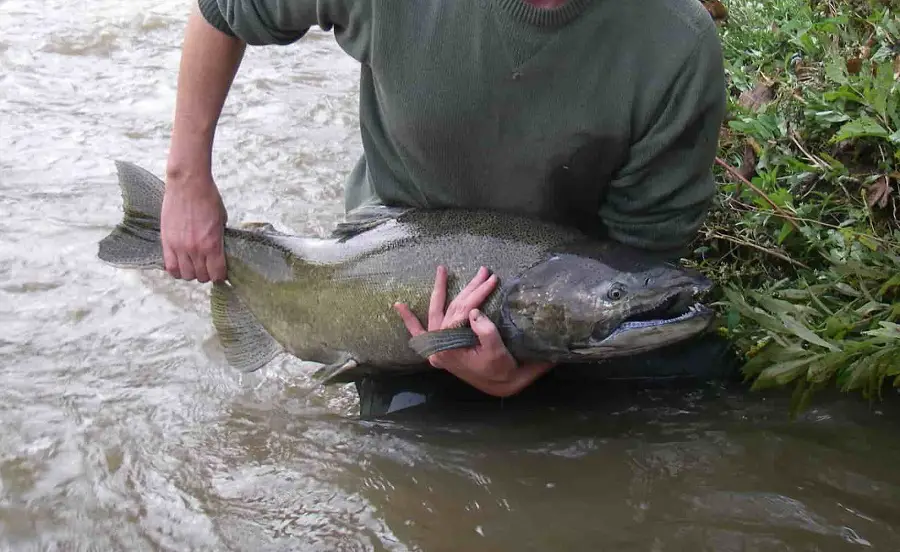
Spin fishing for salmon is likely the most popular way to catch salmon in rivers and it’s one of my most effective methods that I use when I’m guiding. I’ll show you guide methods and the best gear, baits, and lures to use for salmon in rivers.
Methods Used To Spin Fish For Salmon
The methods used to spin fish for salmon include:
- Casting lures
- Jig fishing – Below a float and twitching jigs.
- Bottom bouncing
- Drift fishing
- Float Fishing
- Plunking
- Side Drifting
Spin Fishing For Salmon With Spinning Reels
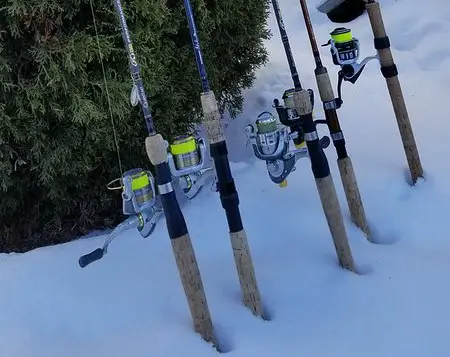
With the spinning reel, you can do almost all of the effective methods that are used in rivers as well as other methods that are used in boats, like trolling.
There are a few things to consider when choosing the right spinning reel for fish like salmon that are huge and strong and can easily rip out 300 feet of line in seconds.
The best spinning reels for salmon will have a good smooth drag system. This is actually very important. The spinning reel must also have good strong gears that won’t get stripped, and it will need to be able to hold enough line for those long runs that salmon are known for.
To effectively spin fish for large salmon, you want to be sure you have a reel that can handle the big hard fighting salmon or you’re going to have some problems, which can include losing fish, breaking lines, breaking rods, and even breaking your reel.
One of the primary advantages of using a spinning reel for salmon fishing is that they are easy to cast, and most anglers already have experience with them since that is the type of reel many kids grow up using.
Another advantage that I see and appreciate as a guide is that spinning reels have a good smooth drag, so once it is set at the proper tension, it does all the work for the angler.
A good spinning reel drag will maintain a nice steady pressure, which makes it very user-friendly, even for beginners.
There are some spinning reels that just do not work well for salmon, and I have seen clients and other anglers lose big salmon because of these bad spinning reels.
Cheap spinning reels often have drags that are not smooth, and this can result in a broken line, or a broken rod. In fact, I have seen a lot of rods get broken from big salmon, and most of the time, it’s due to the drag sticking.
For this reason, I suggest you look into getting one of the proven spinning reels that I use and the ones that other guides and good anglers use.
Spinning reels for salmon don’t have to be very expensive to work well, so a good salmon reel can range from $75.00 to over $500.00.
Best Line For Salmon Fishing With Spinning Reels
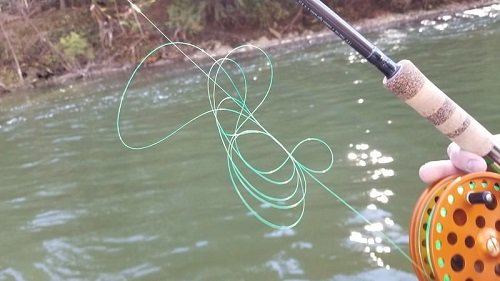
It’s important to have a good line and the right type of line for salmon fishing.
When it comes to the best line for salmon fishing with spinning reels, you have a few options, and it will depend on the methods that you use.
You could choose Monofilament, Copolymer, or a braided line. All will work, some will work better than others depending on the method you use.
The best all-purpose fishing line for salmon fishing with spinning reels for anglers and guides fishing around the Great Lakes region is 12 to 14-pound Sufix Elite monofilament line.
The Sufix Elite line is strong and thin, yet still supple, and is good for all methods of salmon fishing.
If you are fishing big rivers on the West Coast or the big rivers like the Niagara River, the guides use a 16 to 18-pound mainline. However, there are times when a 10-pound line or a 20-pound line might be better.
The Sufix Elite line is also the best line for guys that float fish.
The reason I like the Sufix Elite line is that I have extensively tested it when casting lures, when float fishing, when bottom bouncing or drift fishing, and when plunking. It has some stretch, which saves leaders, and it’s easier to use and has fewer tangles, which is best for beginners.
Sufix Elite is also recommended by other river guides and river anglers who fish for both salmon. It works well on spinning reels as well as baitcasting reels and Centerpin reels.
For more advanced anglers who float fish or lure fish, a braided line can be a better option. It’s strong but with a much thinner diameter, which means more line on the reel, and the no-stretch properties of the line make hook sets better.
This line also allows the bait to sink faster, and it doesn’t get pushed around by the current, which helps you control the speed of your bait during your presentation.
If you have been following my other articles, you may already know that when presenting a bait, I believe speed is the most critical factor to a great presentation and catching ten times more fish, which is why you should learn to control your bait speed.
Braided lines also tend to be more buoyant, which is a benefit when float fishing. New anglers and anglers not used to using braided lines often have issues with braided lines wrapping around the tip, It’s one of the main reasons I don’t use it when guiding.
However, you can get used to it, and it’s best if you have some experience fishing before you go with braided lines.
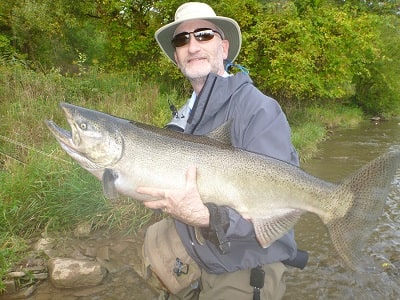
As mentioned above, 12 to 14-pound mono is a good choice for salmon around the great lakes, but for braided lines, 20 to 30-pound line is ideal since the diameter will be closer to 10 to 12 pounds.
I do find lines that are too thin can be problematic. A 14-pound braided line is usually close to about a 4-pound diameter, whereas a 30-pound braid is closer to a 12-pound diameter.
The reason for the variation in line size, 12 to 14 pounds, or even up to 18 pounds, is due to the size of the river or the method you use. On smaller creeks or rivers that can easily be walked and where you can chase after running salmon, even a 10lb or 12-pound line on your reel should be enough.
On very large or fast rivers, or rivers where you can not chase a salmon up or down a river, a 14 to 16-pound line on your reel is better. You will often see West Coast anglers and guides using 14 to 18-pound lines on their reels.
Whereas, great lakes salmon anglers and guides on the smaller rivers will be using 12-pound lines more often.
Also, for angler casting lures, 18 pounds is a good option since the salmon are less likely to notice the line since the lure is moving fast.
However, when using bait, a lighter leader of 10 to 14 pounds is often required since the bait is moving slowly, and the salmon may see the leader if it’s too heavy. Therefore, there is no need for an 18-pound mainline. I’ll discuss some of the disadvantages of the heavier lines below.
Other good lines for fishing for salmon include:
- Sufix Promix Fishing Line – 12 and 14 pounds. This is a cheaper line that river anglers like.
- Sufix Advanced Copolymer – Copolymer lines tend to have strong knot strength, and better abrasion resistance, and better knot strength and are good for lure fishing.
- PowerPro Braided Spectra Fiber Line – 20 – 30 pounds – I like braided lines for fishing with lures, and they can be good when float fishing too.
- Berkley NanoFil Uni-Filament Line – 20 – 30 pounds – This is a good line when fishing with lures.
Check out Best Lines For Salmon Fishing.
Advantages And Disadvantages Of Line Weights
I find that lighter lines cast better, tangle less, and are more supple in cold water and cold air temperatures, especially when it’s below freezing. Lighter lines can provide better action to your lures as well, and they are much lighter which prevents line sag or line sink when you are float fishing.
Lighter lines are just all-around better lines to use, yet many anglers still use lines that are way too heavy. As a general rule of mine, I always recommend going with the lightest line possible.
I hear guys recommending to use 20 pounds or 25-pound line for salmon because the salmon are often over 20 or 30 pounds. The honest truth is that this is just dumb!
The reason they do this is that they think to land big salmon, they need a heavy line to get them in. The reason I say this is dumb is that most of the time, you need to use a lighter leader and a lighter smaller hook just to get the salmon to bite your bait. 20 pounds plus line might be ok for trolling or casting lures, but not for baits.
What these guys that use heavy lines don’t realize is that if your leader is only 12 or 14 pounds, why do you need a 20-pound mainline on your reel, it’s useless. You can’t use all the strength of the 20-pound line anyways, or you will just break off your leader, or you will bend or break hooks.
The other thing is that the heavier the line, the less line you can put on your reel, which can be a problem when a giant salmon decides to run 200 feet down the river when using a 12-pound leader.
Also, many reels, especially the cheaper ones, don’t even have a drag capable of 20 pounds of resistance. I’ve seen 4000-size reels with less than 10-pound drags.
When choosing the right weight line for your reel, I usually recommend 2 to 4 pounds heavier than your heaviest leader. I rarely use a leader of more than 12 pounds for Great Lakes Salmon and 14 pounds for West Coast Salmon.
Leader Size For Salmon Fishing
First, I always use Fluorocarbon leaders because they are less visible to the fish and they are very abrasion-resistant. I use fluorocarbon leaders even when fishing with lures.
The leader length will depend on the method I use and the setup.
I always use the lightest leader possible. This means I want to use a leader thin enough that the salmon won’t see it but strong enough that I’m not going to break off.
Using too heavy a leader and too heavy of a hook is why most guys catch only one salmon when guys like me and my clients are using ten and 12-pound leaders on smaller rivers and are catching 25.
The truth is that salmon can be line-shy, especially when bait fishing in smaller clear rivers or when they are nervous due to other anglers around. Using a smaller, lighter leader means more bites.
Thick and heavy leaders might be best in fast water or off-colored water or when using lures, but that is not the type of water we often fish in.
Not sure what line is best for you, your method, and for the rivers that you fish, let me tell you what I use and how I break it down.
Salmon Leader Weights For Small to Mid-Sized Rivers
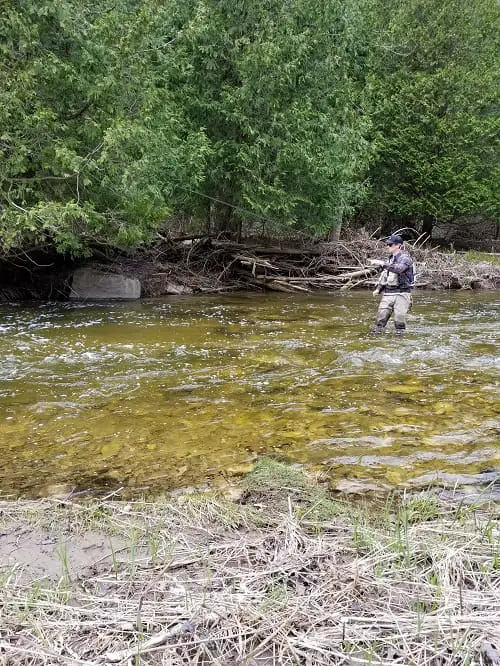
Small to medium-sized salmon streams, which can be 12 to 40 feet wide, a lighter 12 to 14-pound line on the reel combined with a 10 to 12-pound fluorocarbon leader is what I use because I know that I or my clients can walk the banks easily and chase the fish up or down the river if needed.
When using lighter lines like this, I get all the benefits of the lighter line on the reel while still being able to land fish. I probably land 95% of my salmon on 12-pound test without ever breaking my mainline or leader.
Salmon Leader Weights For Wooded Rivers And Fast Water
The only time I would prefer a 14-pound leader in a smaller river is when I’m fishing heavily wooded sections where I will need to apply more pressure to steer big salmon away from logs and wood. you may not get as many bites with the heavier leader but you will also have more chance to land the ones that do bite.
I also find that in faster water, you can get away with a heavier leader since the bait is moving faster, and the salmon have to react quickly if they want your bait. Also, fighting salmon in faster water is more difficult since you are fighting the salmon, and the current and a heavier leader help.
Lastly, I will often upsize my leader by 2 to 4 pounds in dirty or off-colored water since the salmon won’t be able to see the leader in this type of water.
The downside to a heavy leader is that you need to use bigger, thicker hooks, otherwise you will break or bend hooks.
Salmon Leader Weights In Big Rivers
For larger rivers of 60 feet to hundreds of feet wide and rivers with very fast flows, I would go with a 14 to 16-pound leader.
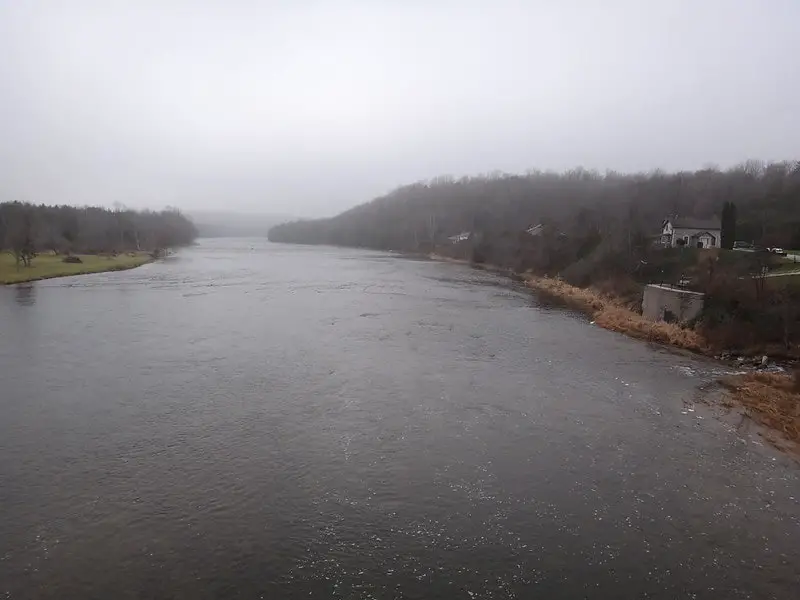
The reason for this is that on these very large rivers, the salmon may be able to run 200 feet across the river, or they might run up or down the river, and you may not be able to chase them. Therefore you need a heavy enough leader to be able to control them and get them into the net.
I discuss the best leader brands, types, and more on leader sizes for salmon on my page Salmon Leaders: Best Types And Sizes
Spinning Rods For Salmon
I like to use longer rods to spin fish for salmon, but I will use different rods for different methods.
When casting lures for salmon, I like rods in the 8 to 9-foot range.
You could use a standard 7-foot rod for salmon, but if you are serious about fishing for salmon and want to be able to catch as many as possible as easily as possible, there are many advantages to a longer spinning rod.
The longer length of 8 to 9-foot spinning rods gives you longer casts with lighter lures, such as spinners, and longer casts with baits and weights.
The longer rod also helps you play the fish better and can keep your line higher and away from shallow rocks when a big salmon runs far up or down the river. The longer length can also help protect lighter leaders.
When float fishing for salmon, I like rods 11 to 14 feet long. Most of my float rods are 13 or 14 feet long.
Longer rods help with casting baits and floats, and they help with line control by keeping the line up off the water and with the mending of the line, which improves presentation.
The longer rod can also act like a giant shock absorber that will protect light leaders often used when bait fishing.
I discuss the best fishing rods for all the different methods on my page Best River Fishing Rods For Salmon.
Spin Fishing With Lures
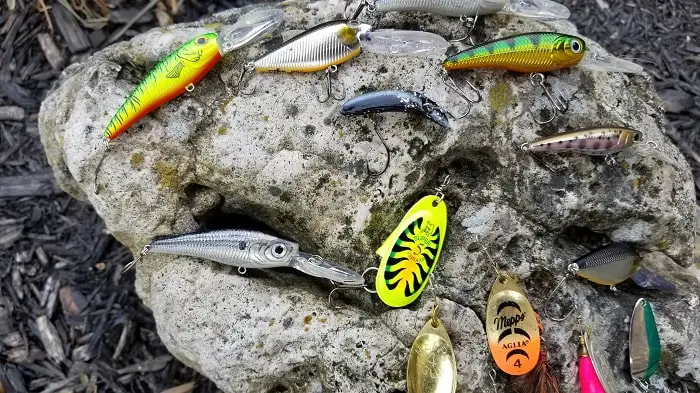
Lure fishing can be a very effective and fun way to catch salmon. There are a lot of anglers that use spinning reels to cast lures.
I use techniques that enable my clients to cover the water more effectively, which in turn means more salmon in the net.
Covering the water effectively means covering it from top to bottom of the water column and also being able to cover the spot well and not miss any spots.
With lure fishing, it’s also important to know what types of lures to use to entice bites from the salmon. With some lures, I will impart action to them, and with other lures, I allow the lures’ own action to do the job.
Getting the lure down to the fish is equally important, and I have found that many anglers just cast and retrieve a lure, but they have no idea if their lure is deep enough or not. A lure that is 10 feet over the salmon’s head might not get noticed or is too far from the salmon to trigger a bite.
However, a lure that is 2 or 3 feet in front of a salmon becomes an easy target and will get grabbed much more often.
I even have lures that I use specifically when the salmon are not aggressive or are nervous due to low clear water or other anglers.
Knowing the most effective lures and how to fish them will also help you catch more salmon. I discuss the best lures and how I fish them on my page, Lure Fishing For Salmon
Jig Fishing For Salmon
Jig fishing for salmon is a lesser-known method used to spin fish for salmon. However, it can be very effective and sometimes deadly when other baits or lures just aren’t working.
I drift lightweight jigs under a float when I’m float fishing for salmon, but I also fish jigs using the bottom bouncing method or drift fishing methods.
Many angers and guides, myself included, will cast and retrieve jigs using a jigging or twitching motion. This can be as effective as any lure out there.
The great thing with jigs is they are effective and can be fished in all depths. Fishing jigs is very effective in pocket water or when salmon are hiding close to large boulders.
I discuss jig fishing for salmon in another article.
Bottom Bouncing For Salmon
Bottom bouncing is another method for salmon and is a good method to use in shallow sections of the river and in pocket water.
Bottom bouncing is often done using spinning reels but could be done using baitcasting reels or even Centerpin Reels.
You can bottom bounce in most types of water. I discuss some advanced methods to help you catch more salmon. The technique is basically the same for all species. Just be sure you have the right gear and lines for big salmon. Check my page, Bottom Bouncing – 5 Proven Guide Tips For More Fish.
Drift Fishing For Salmon
Drift fishing for salmon is basically the same as bottom bouncing with some minor changes. While bottom bouncing is great in pocket water, smaller pools, and when fishing close, drift fishing is better suited for bigger and deeper rivers or where long casts are required.
Most anglers that do drift fishing will use spinning reels.
Drift fishing can be done in deep or shallow sections of the river, and drift fishing with spinning reels allows you to cast far out while still controlling your drift.
For details on how to set up a drift fishing rig, or how to do the drift fishing method, check out my page on Drift Fishing For Salmon.
Float Fishing For Salmon
Float fishing is arguably the most effective way to catch salmon.
Anglers interested in catching salmon should learn this method because there are times when other methods just won’t work as well. As of now, I still believe that most anglers who float fish for salmon are using spinning reels.
Float fishing is the method I use the most when fishing for salmon, however, prefer and believe that float fishing with a Centerpin reel is much more effective.
Float fishing allows you to drift a bait just off the bottom and in the strike zone for a long time. Float fishing also allows you to cover the water very precisely and effectively.
Plunking For Salmon
Another method is known as plunking. Plunking is a method that can be used in rivers, in slow water, on piers, and even out in the lake or the ocean. Spinning rods and reels are the preferred choices for this method.
Plunking simply refers to casting a bait and a large heavy weight that sits on the bottom. The weight anchors the bait close to the bottom, and then you wait for the salmon to swim by and eat your bait.
Anglers will cast the bait out, and put the rod into a rod holder, and just wait. They might reel in and try another spot in 10 or 20 minutes.
If the salmon is not on the move, this is not a very productive method, but if the salmon are swimming through the area, there is a chance to catch some with this method.
To see the best setup for plunking for salmon and the methods on how to do it effectively, go to my page, Plunking For Salmon.
Best River Fishing Gear For Salmon
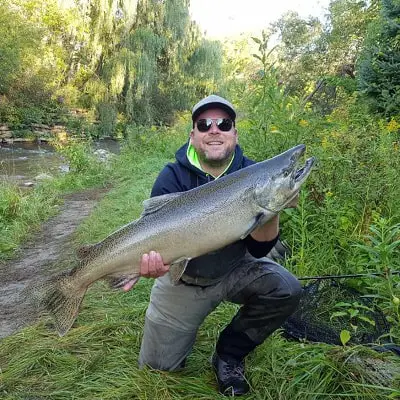
I am often asked either what I should bring on a guided trip or what gear I need when fishing for salmon.
So, I made an entire page on all the essential gear that I recommend to my clients and river anglers.
This is stuff you should have or consider having if you fish rivers. I also discuss which products and brands are guide-tested, field-tested, and are best buys.
Tight Lines,
Graham

I have been running 8lb braid main line with 14 lb fluorocarbon leaders for over 20 years.I catch plenty of 25lb kings with this setup.Thin braid casts great.Set your drag,don’t horse them in.I have never been spooled with 250 to 300 yrds.
leader size seems lite for Oregon salmon . mostly bank fish mid size rivers.
What do you recommend?
I fish in a small/ narrow river and I have difficulty figuring out how to properly weight my line to get the hook deep enough. I use a float as well, but I’ve been trying to learn by doing. I figure it would be easier if someone has some strategies and techniques that would be extremely helpful.
thanks
Hi Corey,
For a float, the weight will depend on the float size, and your float size will depend on the depth and velocity of the stream or spot your are fishing. This means you may need to adjust and change both your float and the amount of weight. Either way, use a similar setups to this article 5 Float leader Setups.
Graham
This helps a lot on tips and tricks thank you
Thanks and Good Luck.